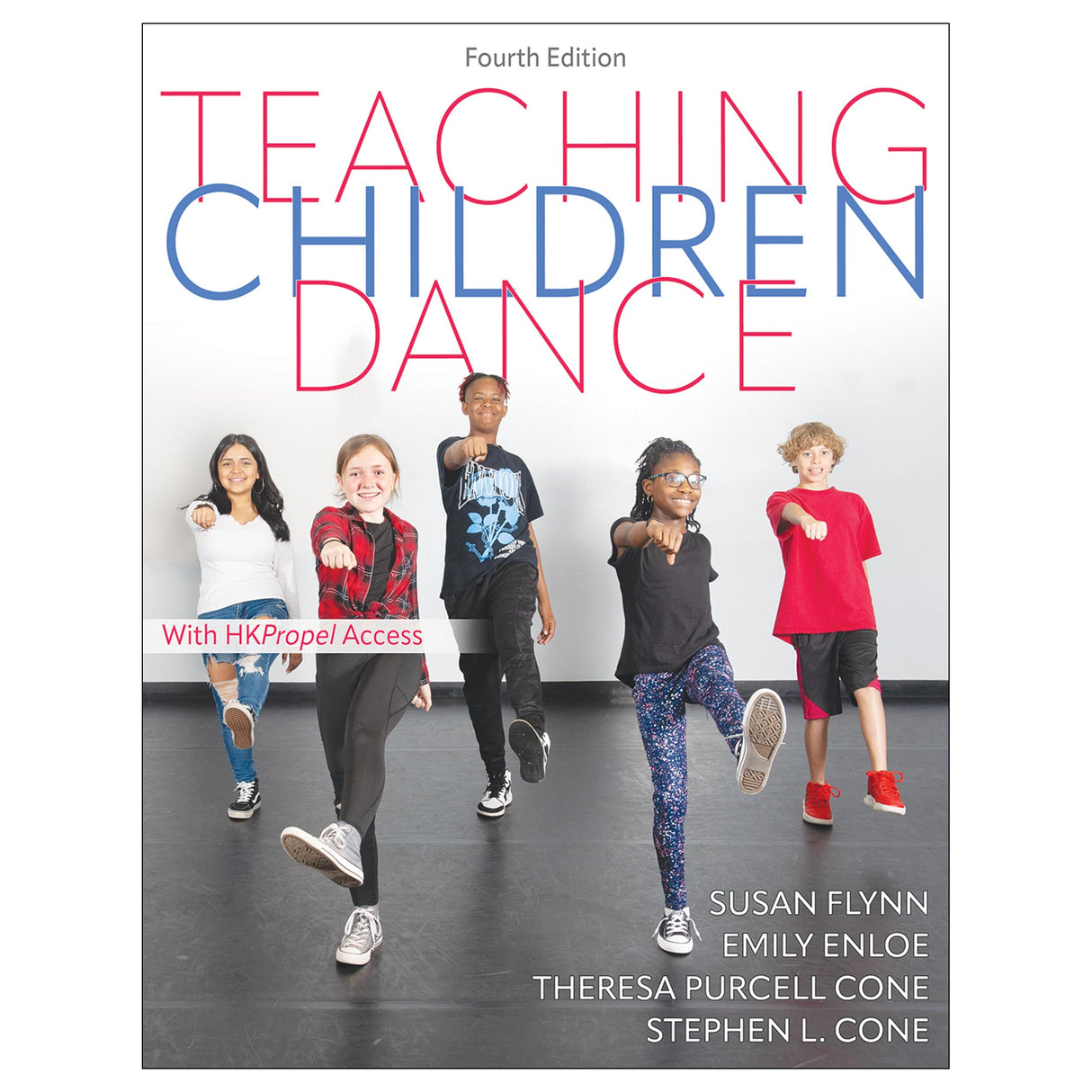Teaching Children Dance 4th Edition Ebook With HKPropel Access
$93.95 CAD

What’s New in This Edition?
New material in the text—which contains learning experiences for physical education, dance, and classroom settings and is geared toward K-12 students of all ability levels—includes the following:
- Two new chapters that feature 32 new learning experiences for popular, fitness, and social dances, as well as for folk and cultural dances based on traditional movements and songs from around the globe
- Instructional videos of teaching techniques, movements, and dances from the two new chapters
- Online resources, accessed through HKPropel, that include PowerPoint presentations, gradable assessments, and forms that can be used as is or adapted
Dance an Inherent Component of Education
“This latest edition of Teaching Children Dance brings a new perspective focused on dance as an inherent component of a child’s education,” says coauthor Susan Flynn. “Since our last edition, educational issues have refocused on students gaining knowledge and skills that can be applied to all aspects of their lives. Dance is one mode for learning that involves using the body and the senses to gather information, communicate, and demonstrate conceptual understandings.”
Book Organization
The text is organized into two parts, with part I’s seven chapters providing the foundation for developing dance learning experiences and offering ideas for planning a yearlong program, a unit, or a single lesson. Part II contains two chapters of creative dance learning experiences and two chapters on choreographed learning experiences. Each learning experience includes learning outcomes; ideas for the introduction and warm-up, development, and culminating dance; variations and adaptations; and assessment suggestions that are directly linked to each outcome.
Fun Learning for All Ability Levels
Teaching Children Dance offers dance instructors insight into designing lessons for students of all skill levels, including those with disabilities, and provides a variety of teaching strategies, assessment tools, and instruction on effective demonstrations—all to make the learning experience fun and motivating for the dancers.
“We’ve developed learning experiences that encourage creativity, positive social interaction, and motor skill development,” says Flynn. “Students view dance as a way to have fun. This opens the door for dance to be a welcomed activity in the school curriculum.”
Note: A code for accessing HKPropel is included with this ebook.
Audience
Undergraduate text for general courses in dance, physical education, or elementary or secondary teaching methods courses. Reference for physical education, dance education, and classroom teachers or related professionals who teach dance to K-12 students in a variety of settings.Chapter 1. Understanding the Importance of Teaching Children’s Dance
What Is Children’s Dance?
Why Teach Children’s Dance?
What Are the Benefits of Children’s Dance?
Applying 21st-Century Skills to Teaching Dance
Meeting the Whole Child Through Dance
Linking the Physical Activity Guidelines to Dance
Summary
Questions for Reflection
Chapter 2. Presenting Essential Content for Children’s Dance
The Body
Body Shapes
Space
Time
Force
Flow
Relationships
Dance Forms
Summary
Questions for Reflection
Chapter 3. Designing a Dance Program
Planning a Yearlong Dance Program
Planning a Dance Unit
Planning the Dance Lessons
Sample Unit and Lesson Outline
Interdisciplinary Connections
Summary
Questions for Reflection
Chapter 4. Creating a Dance Education Setting
Class Size
Equipment and Teaching Materials
Facilities
Class Frequency and Length
Community Characteristics
School Policies
Program Advocacy
Summary
Questions for Reflection
Chapter 5. Making Teaching Effective
Helping All Students Learn
Using Various Teaching Styles and Strategies
Motivating Learners
Establishing Protocols and Rules
Creating a Safe Learning Environment
Presenting Demonstrations
Providing Feedback
Engaging Students in Performances
Observing and Responding to Dance
Summary
Questions for Reflection
Chapter 6. Assessing Children’s Learning in Dance
Teacher Assessment of Program
Teacher Assessment of Students
Peer Assessment
Student Self-Assessment
Assessment Instruments
Summary
Questions for Reflection
Chapter 7. Including All Children in Dance
Knowing Your Students With Disabilities
Creating an Inclusive Environment
Implementing Inclusive Teaching Strategies
Inclusive Dances
Summary
Questions for Reflection
Part II. Learning Experiences
Chapter 8. Learning Experiences for Kindergarten, First Grade, and Second Grade
Neighborhood Friendship Streamer Dance
Floating Clouds and Rain Showers
Run, Hop, Jump, Skip
The Playground
Ocean Waves and Swimmers
Spaghetti Dance
Balloon Dance
Percussion Instrument Dance
The Hungry Cat
Circus Dance
Connect the Spots
Frog Dance
Chapter 9. Learning Experiences for Third Through Eighth Grades
Dancing Homework Machine
Creative Square Dance
Action Words
Baseball Dance
Birthday Celebration
Partner Dance
Three Sport Dances: Sport Add-On, Sport Web, and Sport Pictures in Action
Dance Maps
Create Your Own Hip-Hop Dance
Funky Shape Museum
Stick Figures Come Alive
Chapter 10. Learning Experiences in Popular, Fitness, and Social Dances
Overview of Popular, Fitness, and Social Dances
Teaching Strategies for Choreographed Dance Lessons
Basic Social and Popular Dance Movements
Learning Experiences
5, 6, 7, 8 Steps Line Dance
16-Step Contra Dance
Disco Fever Dance
Funky Cowboy Line Dance
Grapevine Slide Dance
Hey Baby Line Dance
The Hit Man Contra Dance
Honky Tonk Line Dance
Honky Tonk Circle Dance
Rockin’ Shuffle
Rock This Party Line Dance
Baba Hou Fitness Dance
T Fitness Dance
Cha-Cha Plank Fitness Dance
Circle Jam Fitness Dance
Tabata Dance
Salsa
Swing
Cha-Cha
Create Your Own Fitness Dance
Create Your Own Popular Dance
Sample Rubrics
Chapter 11. Learning Experiences in Folk and Cultural Dances
American Square Dance
Bele Kawe
Appalachian Big Circle (Elementary Version)
Appalachian Big Circle (Secondary Version)
Kinderpolka
La Raspa
Mayim, Mayim
Samoan Sasa
Tanko Bushi
Tinikling
Virginia Reel
All ancillaries are free to adopting instructors through HKPropel.
Test package. Contains 125 questions in multiple-choice, true-false, multiple-response, and matching formats. The files may be downloaded for integration with a learning management system or printed for use as paper-based tests. Instructors may also create their own customized quizzes or tests from the test bank questions to assign to students directly through HKPropel. Multiple-choice questions are automatically graded, and instructors can review student scores in the platform.
Presentation package. Features more than 115 PowerPoint slides of text, artwork, and tables from the book that can be used for class discussion and presentation. The slides in the presentation package can be used directly within PowerPoint or printed to make handouts for students. Instructors can easily add, modify, and rearrange the order of the slides.
Instructors also receive access to all student materials in HKPropel. For Teaching Children Dance, Fourth Edition, this includes video demonstrations of dance movements, choreographed dances, and teaching techniques; the book’s Questions for Reflection along with suggested answers; and rubrics and other forms.









